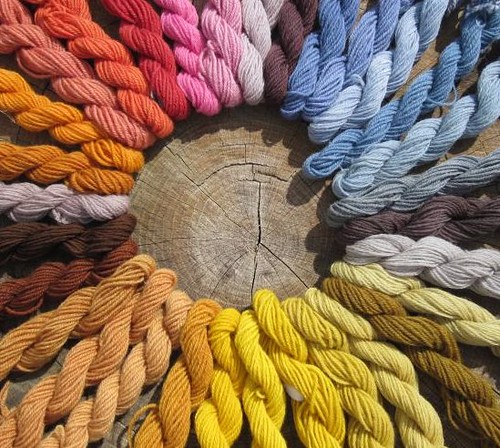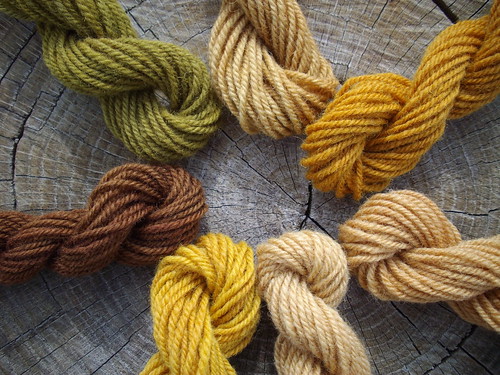Hi All,
I have been a bit quiet lately, going around doing my editors duties, commenting on your lovely posts, but really not much else. Sorry about that!
I have been working on one refashion in particular but more will be revealed at a later point. Other than that I haven't been very active online as there have been some major things going on offline (all good I promise).
One thing was that I went to France with a friend to visit her family. While we were their we did some serious experimenting with natural dyes. We made a flickr group to show off the photos. I was so amazed at the variety of colour and the intensity of some of the colours.
So why am I telling you all this you might ask - what has it got to do with refashioning. Well for me dyeing is refashioning. You have an item you love the fabric and the shape of, but not the colour. A bit of dyeing can fix that. And this is my bid to try and convince you that there is no need to buy synthetic dyes to get the colours you want. It can be done just as easily and with a lovely result too by using plant material.
And is this then a refashion in itself? Of course it is. You see I have been buying this 100% natural/white wool in charity shops but they were all a grubby and discolored. So I decided to split them into mini skeins and use them as samples for these dyeing experiments. Now I have a colourwheel of colours (see photo above) and I am going to use them to make a granny square blanket/shawl. So from unwanted grubby wool to colourful granny square shawl.
The best bit of this is that now I also know what colours I can expect from variety of plants and I have used this to dye some bunny yellow cotton into a more attractive (to me at least) burnt orange colour for another shawl. I think I am becoming a bit of a shawl lady. I will show you this project later when I start making the shawl.
My friend Cecile took some wonderful notes on all our experiments and she is writing them up as very informative posts on her blog, Ways of the Whorl. Below I will show you some of the dyes we did and direct you to her post on it and more pictures for you to see.
Black Beans (blues)
'Natural Dyeing Take 3: Black Beans' Post by Cecile.
My flickr set of photos of black bean dyeing.
Red and Yellow onion skin (oranges, yellows, brown and green)
Natural Dyeing Take 2: Onion skins Post by Cecile.
My flickr set of photos of red onion skin and yellow onion skin dyeing.
The onion skin dyeing photo above is borrowed from Cecile from Ways of the Whorl (copyright Cecile)
What else have I been doing lately. Well I decided to move the Historic Crafts blog to a blogger platform too! It is now http://historic-crafts.blogspot.com. I have already met some lovely people on Ravelry who have signed up as authors to help me show of historic related crafts to the world. If you are interested in this - get in tough (eddie at roued dot com).
I have also made a decision to revive and focus a bit more on my own crafty and other activities on my own blog www.roued.com . My only problem here is that I am struggling to find a better name for this blog. At the moment I've just named it "Eddie's". PLease, please help! Any suggestions will be very welcome.
I can't wait to see all your dyeing projects and your shawls for that matter!
Take care,
Eddie




9 comments:
As an after though I just wanted to tell you all that I have been doing a bit of cleaning in the labels today. I have added some of our new contributors to the contributor list in the left hand sidebar.
Can I remind everyone to use tutorials and not tutorial for their tutorial posts as only posts labeled with the first version will be listed in the sidebar.
Also I have noted some redundant labeling here and there, but I have only edited it where I was already editing. You don't need to use labels such as 'refashion', 'recycled-fashion' or 'reconstructed clothing' as everything on this site should fit in these categories anyway.
If you wish to use a label that is not in one of the lists on the left - please email the editors and ask if it can be added to the list.
Take care,
Eddie
Your yarns look so pretty-- I really wouldn't have thought that black beans would make blue dye!
I'll certainly check out the posts on your friend's blog--I've played around with dyeing before (with synthetic dyes) and am curious to try some more natural ones. Especially for yarn, since I can't use wool and it seems that most of the pretty hand-dyed ones contain it.
This is so weird I just looked up natural dyes a few days ago. I have a shirt that I'd like to turn into a saffron color.
Thank you Becky - I to was very surprised that Black Beans worked and it is apparently a lot less complicated than dyeing with indigo.
If you want a saffron colour you can use saffron but cheaper alternative is yellow onion skins which gives very deep orange/yellows.
Eddie
too cool! i'm all about keeping things as natural as possible, and i have been thinking about getting into dyeing soon. i definitely agree that it is a great refashion technique!
I'm really keen to try natural dye too, so thank you for this informative post, Erica
I am also very interested in natural dyes. I've wanted to dye a wool sweater red or pinkish red but haven't found anything online regarding natural dyes for that yet. What do you think?
Thank you Jane and Erica. I hope you both have a go with it. It's so much fun.
That sounds like a cool project Lovenicky. In terms of red and pinky reds I would go with Brazilwood.
If you look at our colourwheel above there is a red and two pinks following it clockwise around 11 o'clock. They are all different methods with brazilwood. If you are interested in more detail I will talk about it on my blog (www.roued.com)
Post a Comment